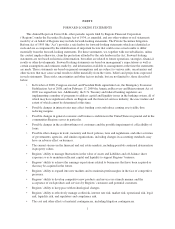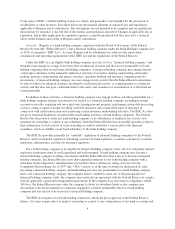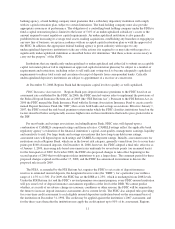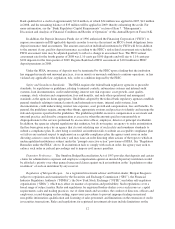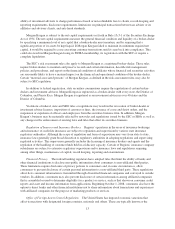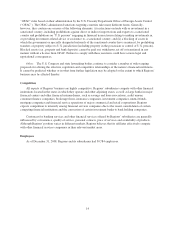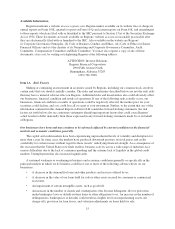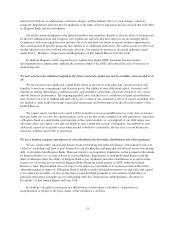Regions Bank 2008 Annual Report Download - page 18
Download and view the complete annual report
Please find page 18 of the 2008 Regions Bank annual report below. You can navigate through the pages in the report by either clicking on the pages listed below, or by using the keyword search tool below to find specific information within the annual report.debt service and to pay dividends to its stockholders. This is compared to an anticipated common dividend
requirement, assuming current dividend payment levels, of approximately $277 million and preferred cash
dividends of approximately $175 million for the full year 2009. Expected debt maturities in 2009 are
approximately $425 million.
Although Regions currently has capacity to make common dividend payments in 2009, the payment of
dividends by Regions and the dividend rate are subject to management review and approval by Regions’ Board
of Directors on a quarterly basis. Preferred dividends are to be paid in accordance with the terms of the CPP. See
Item 1A. “Risk Factors” of this Annual Report on Form 10-K for additional information.
In the current financial and economic environment, the Federal Reserve has indicated that bank holding
companies should carefully review their dividend policy and has discouraged payment ratios that are at
maximum allowable levels unless both asset quality and capital are very strong.
Prior to November 14, 2011, unless Regions has redeemed all of the Series A Preferred Stock issued to the
U.S. Treasury on November 14, 2008 or unless the U.S. Treasury has transferred all the preferred securities to a
third party, the consent of the U.S. Treasury will be required for Regions to declare or pay any dividend or make
any distribution on common stock other than (i) regular quarterly cash dividends of not more than the current
level of $0.10 per share, as adjusted for any stock split, stock dividend, reverse stock split, reclassification or
similar transaction, (ii) dividends payable solely in shares of common stock and (iii) dividends or distributions of
rights or junior stock in connection with a stockholders’ rights plan.
Capital Adequacy. Regions and Regions Bank are required to comply with the applicable capital adequacy
standards established by the Federal Reserve. There are two basic measures of capital adequacy for bank holding
companies that have been promulgated by the Federal Reserve: a risk-based measure and a leverage measure.
The risk-based capital standards are designed to make regulatory capital requirements more sensitive to
differences in credit and market risk profiles among banks and financial holding companies, to account for
off-balance sheet exposure, and to minimize disincentives for holding liquid assets. Assets and off-balance sheet
items are assigned to broad risk categories, each with appropriate weights. The resulting capital ratios represent
capital as a percentage of total risk-weighted assets and off-balance sheet items.
The minimum guideline for the ratio of total capital (“Total Capital”) to risk-weighted assets (including
certain off-balance sheet items, such as standby letters of credit) is 8.0%. At least half of the Total Capital must
be composed of qualifying common equity, qualifying noncumulative perpetual preferred stock, including related
surplus, and senior perpetual preferred stock issued to the U.S. Treasury under the CPP, minority interests
relating to qualifying common or noncumulative perpetual preferred stock issued by a consolidated U.S.
depository institution or foreign bank subsidiary, and certain “restricted core capital elements”, as discussed
below, less goodwill and certain other intangible assets (“Tier 1 Capital”).
Tier 2 Capital may consist of, among other things, qualifying subordinated debt, mandatorily convertible
debt securities, other preferred stock and trust preferred securities and a limited amount of the allowance for loan
losses. Non-cumulative perpetual preferred stock, trust preferred securities and other so-called “restricted core
capital elements” are currently limited to 25% of Tier 1 Capital. The minimum guideline for Tier 1 Capital is
4.0%. At December 31, 2008, Regions’ consolidated Tier 1 Capital ratio was 10.38% and its Total Capital ratio
was 14.64%.
In addition, the Federal Reserve has established minimum leverage ratio guidelines for bank holding
companies. These guidelines provide for a minimum ratio of Tier 1 Capital to average total assets, less goodwill
and certain other intangible assets (the “Leverage Ratio”), of 3.0% for bank holding companies that meet certain
specified criteria, including having the highest regulatory rating. All other bank holding companies generally are
required to maintain a Leverage Ratio of at least 4%. Regions’ Leverage Ratio at December 31, 2008 was 8.47%.
8





